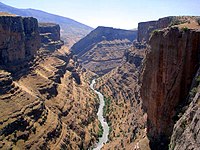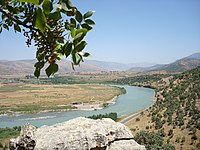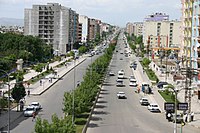Kurdistan
Kurdistan (Kurdish: کوردستان, romanized: Kurdistan, lit. 'land of the Kurds'; [ˌkʊɾdɪˈstɑːn] ),[5] or Greater Kurdistan,[6][7] is a roughly defined geo-cultural region in West Asia wherein the Kurds form a prominent majority population[8] and the Kurdish culture, languages, and national identity have historically been based.[9] Geographically, Kurdistan roughly encompasses the northwestern Zagros and the eastern Taurus mountain ranges.
For other uses, see Kurdistan (disambiguation).
Kurdistan generally comprises the following four regions: southeastern Turkey (Northern Kurdistan), northern Iraq (Southern Kurdistan), northwestern Iran (Eastern Kurdistan), and northern Syria (Western Kurdistan).[3][10] Some definitions also include parts of southern Transcaucasia.[11] Certain Kurdish nationalist organizations seek to create an independent nation state consisting of some or all of these areas with a Kurdish majority, while others campaign for greater autonomy within the existing national boundaries.[12] Though, the delineation of the region remains disputed and varied, with some maps greatly exaggerating its boundaries.
Historically, the word "Kurdistan" is first attested in 11th century Seljuk chronicles.[13] Many disparate Kurdish dynasties, emirates, principalities, and chiefdoms were established from the 8th to 19th centuries. Administratively, the 20th century saw the establishment of the short-lived areas of the Kurdish state (1918–1919), Kingdom of Kurdistan (1921–1924), Kurdistansky Uyezd i.e. "Red Kurdistan" (1923–1929), Republic of Ararat (1927–1930), and Republic of Mahabad (1946).
Iraqi Kurdistan first gained autonomous status in a 1970 agreement with the Iraqi government, and its status was re-confirmed as the autonomous Kurdistan Region within the federal Iraqi republic in 2005.[14] There is also a Kurdistan Province in Iran, which is not self-ruled. Kurds fighting in the Syrian Civil War were able to take control of large sections of northern Syria and establish self-governing regions in an Autonomous Administration of North and East Syria (commonly called Rojava), where they seek autonomy in a federal Syria after the war.[15]
People
According to 2016 estimate Kurdish Institute of Paris, total population of Kurdistan is around 34.5 million, and Kurds making 86% of population of Northern Kurdistan.[91] There are Arab, Turkish, Assyrian (Syriac), Armenian and Azerbaijani minorities in Northern Kurdistan.[91] In Southern Kurdistan there are Christian (Assyrian and Armenian) and Turkish (Turkmen) minorities as well.[91] Iraqi and Syrian Turkmen share close ties with Turkish people and do not identify with the Turkmen of Turkmenistan and Central Asia.[92][93][94][95][96] Kurdistan has also significant Caucasian population, Caucasians of Kurdistan included Chechens and Ingushes in Varto,[97] Ossetians in Ahlat[98][99] and Circassians. From early stage on, these Caucasians went through a process of Kurdification and thereby had Kurdish as their mother tongue.[100][101][102]






